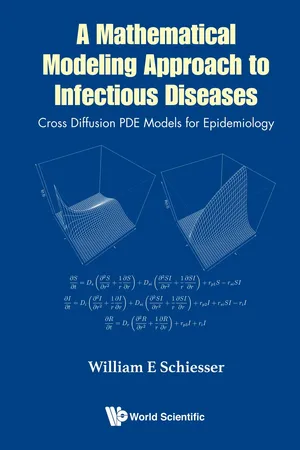
A Mathematical Modeling Approach to Infectious Diseases
Cross Diffusion PDE Models for Epidemiology
William E Schiesser
- 460 páginas
- English
- ePUB (apto para móviles)
- Disponible en iOS y Android
A Mathematical Modeling Approach to Infectious Diseases
Cross Diffusion PDE Models for Epidemiology
William E Schiesser
Información del libro
The intent of this book is to provide a methodology for the analysis of infectious diseases by computer-based mathematical models. The approach is based on ordinary differential equations (ODEs) that provide time variation of the model dependent variables and partial differential equations (PDEs) that provide time and spatial (spatiotemporal) variations of the model dependent variables.
The starting point is a basic ODE SIR (Susceptible Infected Recovered) model that defines the S,I,R populations as a function of time. The ODE SIR model is then extended to PDEs that demonstrate the spatiotemporal evolution of the S,I,R populations. A unique feature of the PDE model is the use of cross diffusion between populations, a nonlinear effect that is readily accommodated numerically. A second feature is the use of radial coordinates to represent the geographical distribution of the model populations.
The numerical methods for the computer implementation of ODE/PDE models for infectious diseases are illustrated with documented R routines for particular applications, including models for malaria and the Zika virus. The R routines are available from a download so that the reader can reproduce the reported solutions, then extend the applications through computer experimentation, including the addition of postulated effects and associated equations, and the implementation of alternative models of interest.
The ODE/PDE methodology is open ended and facilitates the development of computer-based models which hopefully can elucidate the causes/conditions of infectious disease evolution and suggest methods of control.
Contents:
- Introduction to Spatiotemporal Models
- SIR Models
- Cross Diffusion
- Alternative Coordinate Systems
- Vector-Borne Diseases, Malaria
- Vector-Borne Diseases, Zika Virus
Readership: Medical researchers, biologists, applied mathematicians, NIH, WHO, pharmaceutical companies.
Key Features:
- Partial differential equation analysis defining the spatiotemporal evolution of epidemics
- Cross diffusion between affected populations
- Radial spatial coordinates corresponding to the physical system geometry
- This combination of features does not appear in any other book of which the author is aware
Preguntas frecuentes
Información
Chapter 1
Introduction to Spatiotemporal Models
(1.1)Introduction
R graphics utilities.R coding for these models is presented as a series of routines with output presented for each model.(1.2)A Basic PDE Model

| S(x, t) | S population density (susceptibles/m2) |
| I(x, t) | I population density (infecteds/m2) |
| x | distance (m) |
| t | time (s = seconds) |
| L | cross sectional length of incremental area (m) |
| Ds | effective diffusivity for the susceptibles (m2/s) |
| rp1 | net S population growth rate (birth rate - death rate) (1/s) |
| ri | grow rate from S and I interactions ((m2/infecteds) (1/s)) |





Índice
- Cover Page
- Title
- Copyright
- Dedication
- Contents
- Preface
- Chapter 1. Introduction to Spatiotemporal Models
- Chapter 2. SIR Models
- Chapter 3. Cross Diffusion
- Chapter 4. Alternative Coordinate Systems
- Chapter 5. Vector-Borne Diseases, Malaria
- Chapter 6. Vector-Borne Diseases, Zika Virus
- Appendix A1: Function dss004
- Appendix A2: Function dss044
- Index